Input interpretation

carbon (chemical element) | palladium (chemical element) | cadmium (chemical element)
Periodic table location

Periodic table location
Images
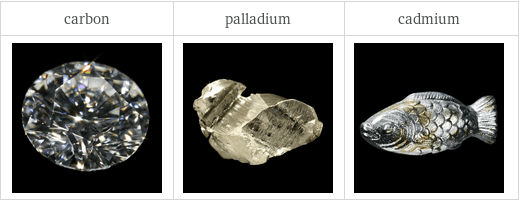
Images
Basic elemental properties
![| carbon | palladium | cadmium atomic symbol | C | Pd | Cd atomic number | 6 | 46 | 48 short electronic configuration | [He]2s^22p^2 | [Kr]4d^10 | [Kr]5s^24d^10 Aufbau diagram | 2p 2s | 4d | 4d 5s block | p | d | d group | 14 | 10 | 12 period | 2 | 5 | 5 atomic mass | 12.011 u | 106.42 u | 112.414 u half-life | (stable) | (stable) | (stable)](../image_source/6ed8225765627662ec5b6d5d4ae1c06c.png)
| carbon | palladium | cadmium atomic symbol | C | Pd | Cd atomic number | 6 | 46 | 48 short electronic configuration | [He]2s^22p^2 | [Kr]4d^10 | [Kr]5s^24d^10 Aufbau diagram | 2p 2s | 4d | 4d 5s block | p | d | d group | 14 | 10 | 12 period | 2 | 5 | 5 atomic mass | 12.011 u | 106.42 u | 112.414 u half-life | (stable) | (stable) | (stable)
Thermodynamic properties
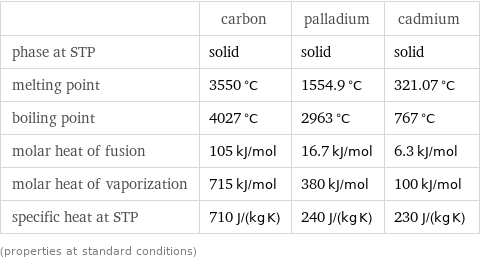
| carbon | palladium | cadmium phase at STP | solid | solid | solid melting point | 3550 °C | 1554.9 °C | 321.07 °C boiling point | 4027 °C | 2963 °C | 767 °C molar heat of fusion | 105 kJ/mol | 16.7 kJ/mol | 6.3 kJ/mol molar heat of vaporization | 715 kJ/mol | 380 kJ/mol | 100 kJ/mol specific heat at STP | 710 J/(kg K) | 240 J/(kg K) | 230 J/(kg K) (properties at standard conditions)
Material properties
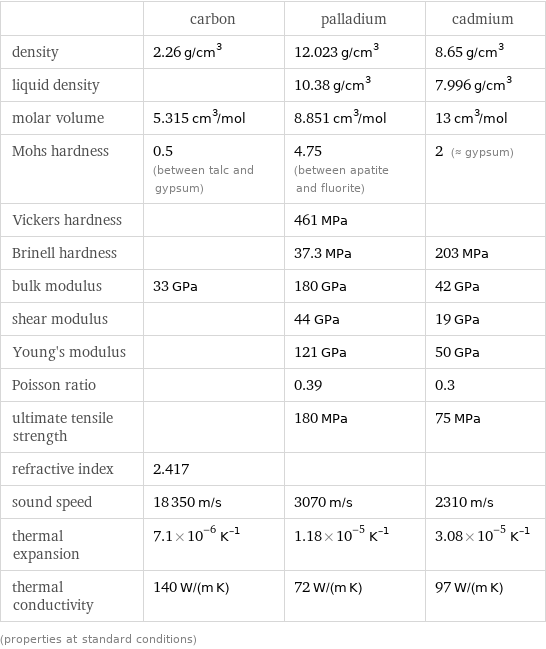
| carbon | palladium | cadmium density | 2.26 g/cm^3 | 12.023 g/cm^3 | 8.65 g/cm^3 liquid density | | 10.38 g/cm^3 | 7.996 g/cm^3 molar volume | 5.315 cm^3/mol | 8.851 cm^3/mol | 13 cm^3/mol Mohs hardness | 0.5 (between talc and gypsum) | 4.75 (between apatite and fluorite) | 2 (≈ gypsum) Vickers hardness | | 461 MPa | Brinell hardness | | 37.3 MPa | 203 MPa bulk modulus | 33 GPa | 180 GPa | 42 GPa shear modulus | | 44 GPa | 19 GPa Young's modulus | | 121 GPa | 50 GPa Poisson ratio | | 0.39 | 0.3 ultimate tensile strength | | 180 MPa | 75 MPa refractive index | 2.417 | | sound speed | 18350 m/s | 3070 m/s | 2310 m/s thermal expansion | 7.1×10^-6 K^(-1) | 1.18×10^-5 K^(-1) | 3.08×10^-5 K^(-1) thermal conductivity | 140 W/(m K) | 72 W/(m K) | 97 W/(m K) (properties at standard conditions)
Electromagnetic properties
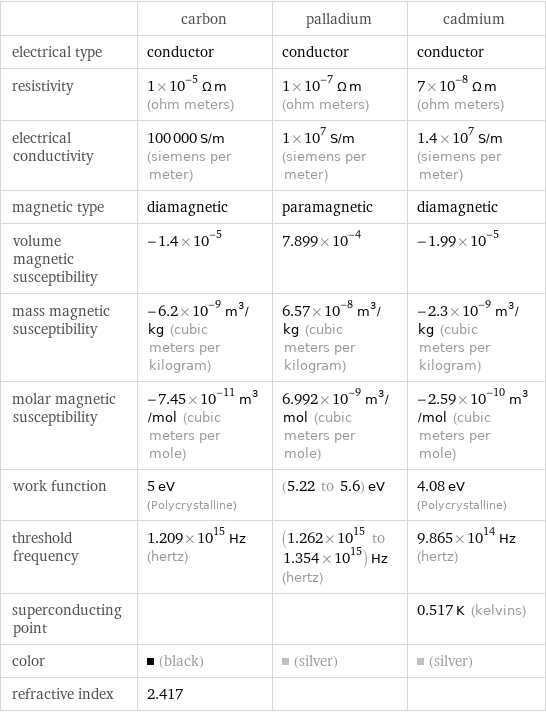
| carbon | palladium | cadmium electrical type | conductor | conductor | conductor resistivity | 1×10^-5 Ω m (ohm meters) | 1×10^-7 Ω m (ohm meters) | 7×10^-8 Ω m (ohm meters) electrical conductivity | 100000 S/m (siemens per meter) | 1×10^7 S/m (siemens per meter) | 1.4×10^7 S/m (siemens per meter) magnetic type | diamagnetic | paramagnetic | diamagnetic volume magnetic susceptibility | -1.4×10^-5 | 7.899×10^-4 | -1.99×10^-5 mass magnetic susceptibility | -6.2×10^-9 m^3/kg (cubic meters per kilogram) | 6.57×10^-8 m^3/kg (cubic meters per kilogram) | -2.3×10^-9 m^3/kg (cubic meters per kilogram) molar magnetic susceptibility | -7.45×10^-11 m^3/mol (cubic meters per mole) | 6.992×10^-9 m^3/mol (cubic meters per mole) | -2.59×10^-10 m^3/mol (cubic meters per mole) work function | 5 eV (Polycrystalline) | (5.22 to 5.6) eV | 4.08 eV (Polycrystalline) threshold frequency | 1.209×10^15 Hz (hertz) | (1.262×10^15 to 1.354×10^15) Hz (hertz) | 9.865×10^14 Hz (hertz) superconducting point | | | 0.517 K (kelvins) color | (black) | (silver) | (silver) refractive index | 2.417 | |
Reactivity

| carbon | palladium | cadmium valence | 4 | 4 | 2 electronegativity | 2.55 | 2.2 | 1.69 electron affinity | 153.9 kJ/mol (kilojoules per mole) | 53.7 kJ/mol (kilojoules per mole) | 0 kJ/mol (kilojoules per mole) first ionization energy | 1086.5 kJ/mol (kilojoules per mole) | 804.4 kJ/mol (kilojoules per mole) | 867.8 kJ/mol (kilojoules per mole) ionization energies | 1086.5 kJ/mol | 2352.6 kJ/mol | 4620.5 kJ/mol | 6222.7 kJ/mol | 37831 kJ/mol | 47277 kJ/mol | 804.4 kJ/mol | 1870 kJ/mol | 3177 kJ/mol | 867.8 kJ/mol | 1631.4 kJ/mol | 3616 kJ/mol

Reactivity
Atomic properties
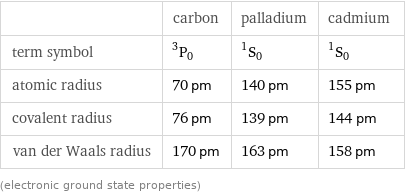
| carbon | palladium | cadmium term symbol | ^3P_0 | ^1S_0 | ^1S_0 atomic radius | 70 pm | 140 pm | 155 pm covalent radius | 76 pm | 139 pm | 144 pm van der Waals radius | 170 pm | 163 pm | 158 pm (electronic ground state properties)
Abundances
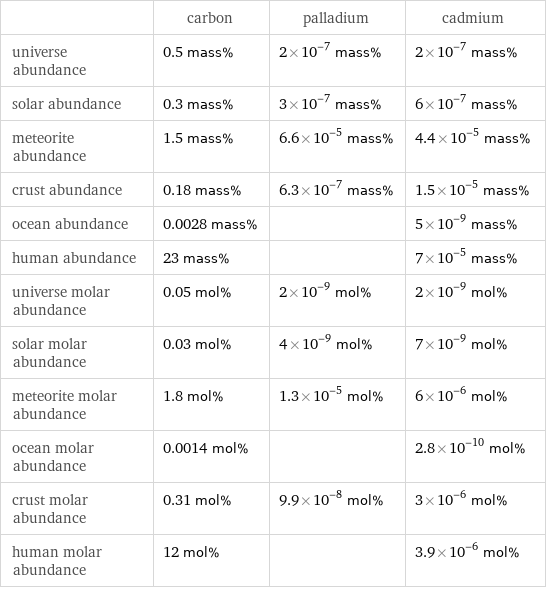
| carbon | palladium | cadmium universe abundance | 0.5 mass% | 2×10^-7 mass% | 2×10^-7 mass% solar abundance | 0.3 mass% | 3×10^-7 mass% | 6×10^-7 mass% meteorite abundance | 1.5 mass% | 6.6×10^-5 mass% | 4.4×10^-5 mass% crust abundance | 0.18 mass% | 6.3×10^-7 mass% | 1.5×10^-5 mass% ocean abundance | 0.0028 mass% | | 5×10^-9 mass% human abundance | 23 mass% | | 7×10^-5 mass% universe molar abundance | 0.05 mol% | 2×10^-9 mol% | 2×10^-9 mol% solar molar abundance | 0.03 mol% | 4×10^-9 mol% | 7×10^-9 mol% meteorite molar abundance | 1.8 mol% | 1.3×10^-5 mol% | 6×10^-6 mol% ocean molar abundance | 0.0014 mol% | | 2.8×10^-10 mol% crust molar abundance | 0.31 mol% | 9.9×10^-8 mol% | 3×10^-6 mol% human molar abundance | 12 mol% | | 3.9×10^-6 mol%